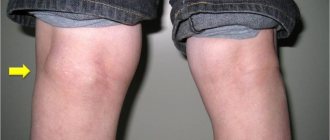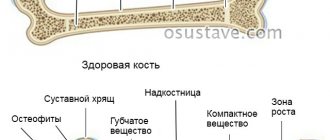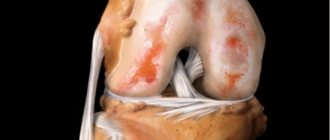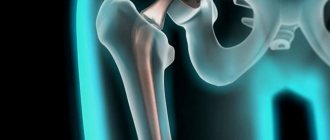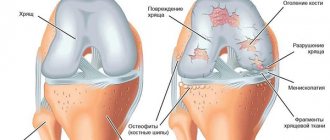What is synovitis of the knee joint?
Synovitis is treated by an arthrologist or orthopedic surgeon
Synovitis is an inflammatory disease of the synovium. Synovitis of the knee joints is a common pathology. It is the knee that suffers most often due to the characteristics of the load and blood circulation of this joint. The disease is equally common in children and adults. If in a child synovitis of the knee joint is most often reactive in nature, as a complication after infections, in adults secondary, or traumatic, synovitis is usually diagnosed.
Synovitis of the knee joint according to ICD-10 is designated M65.9. According to the International Classification of Diseases (ICD-10), synovitis of the knee joint is classified as unspecified inflammation of the synovial membrane due to the variety of forms that this disease can take.
The synovium is a thin, elastic tissue that lines the inside of the joint capsule. With synovitis, this tissue becomes inflamed, which leads to increased secretion of effusion (exudate). Since the knee joint is very mobile, fluid accumulates quickly and the joint swells noticeably. The pathology is dangerous due to its rapid progression. If the inflammation goes directly to the joint capsule and the tissues around it, the prognosis for recovery is unfavorable.
Causes of development and types of disease
The causes of knee synovitis can be divided into three large groups:
- infectious;
- non-infectious;
- traumatic.
Infectious causes and types of inflammation
Infectious synovitis of the knee is associated with the penetration of infection directly into the synovium. This can happen in three ways:
- in case of joint damage;
- with blood flow;
- with the movement of lymph.
Traumatic causes of synovitis, including infectious ones, are discussed separately below, since the disease belongs to traumatic and post-traumatic synovitis.
There are two types of infectious synovitis: specific and nonspecific. Specific inflammation develops as a result of infection of the joint with pathogens of syphilis, gonorrhea, chlamydia, Koch's bacillus and other specific pathogenic agents. In fact, this disease is a complication of the listed pathologies.
Nonspecific synovitis develops due to the presence of a chronic source of infection in the body. They can occur against the background:
- caries;
- tonsillitis;
- boils;
- carbuncles;
- pneumonia;
- prostatitis;
- cystitis;
- urethritis;
- pyelonephritis.
The causative agent of the infection can be Staphylococcus aureus, streptococci, pneumococci, Pseudomonas aeruginosa. Very rarely, a fungal form of the disease is diagnosed, developing against the background of severe systemic mycoses that affect the entire body as a whole.
As a rule, the listed microorganisms penetrate the knee joint through the blood or lymph flow. The exception is infection due to furunculosis. Here, direct infection of the joint can occur if the boils are located in close proximity to the knee.
Infectious synovitis is also called purulent. In this case, purulent exudate accumulates in the synovial membrane. When the synovial membrane is infected, hemorrhagic synovitis of the left knee joint (or right) can also be diagnosed. In this case, exudate mixed with blood and proteins accumulates inside the joint.
As a rule, infectious synovitis of the knee joint is characterized by a rapid increase in symptoms.
The infection can affect one joint or both. In severe cases, pathogenic agents quickly spread throughout the entire limb, causing inflammation not only of the knee, but also of the hip, ankle and foot.
Non-infectious causes
The symptoms of synovitis of the knee together form a syndrome characteristic of many diseases and injuries of the knee (arthritis, arthrosis, dislocation, etc.)
Most often, doctors and patients are faced with non-infectious causes of the disease. These include:
- metabolic disorders;
- endocrine pathologies;
- psoriasis;
- gout;
- autoimmune connective tissue diseases;
- hemophilia;
- chronic joint pathologies.
The listed reasons cause aseptic inflammation in the knee. At the same time, no pathogenic agents are found in the synovial fluid or exudate that accumulates at the site of inflammation. At the same time, non-infectious causes can cause serous-fibrinous inflammation of the synovial membrane, in which a large amount of fibrin is found in the fluid.
Against the background of chronic joint diseases, such as arthritis or arthrosis, chronic forms of synovitis of the knee joint often develop. This is a dangerous disease that leads to changes in the structure of the synovial membrane and requires surgical treatment.
The development of synovitis of the right or left knee joint can be observed against the background of autoimmune diseases (rheumatoid arthritis, systemic lupus erythematosus, vasculitis, etc.).
Also, inflammation in the knee can be caused by diabetes mellitus, which disrupts metabolic processes in the lower extremities. Against the background of rheumatoid arthritis, a rare and dangerous form of the disease can develop - villonodular synovitis of the knee joint.
Allergy as a cause of synovitis
Allergic, or reactive, synovitis of the knee is a pathology often found in children. The cause is a specific reaction of the body to an allergen irritant. Such irritants can be medications, pollen, animal saliva, etc. The reactive form of the disease develops against the background of previous infections. The inflammation is aseptic, since the disease occurs as a result of the effects of antibodies produced by the body to fight infection, but in the absence of pathogenic agents.
As a rule, allergies cause minimal synovitis of the knee joint. This form of the disease is characterized by minor pain and almost complete absence of swelling. In case of allergies to medications, the development of moderate synovitis of the knee joint may occur. These forms of the disease respond well to treatment.
Traumatic causes of synovitis
Since the knee joint is very mobile and constantly loaded, traumatic causes of inflammation in the synovial membrane are separately identified. Thus, damage to the posterior horn of the meniscus causes severe synovitis of the knee joints. Synovitis of the knee joint after injuries to the tendons and ligaments of this joint is often found in professional athletes.
Among the traumatic factors and causes of the development of synovitis of the knee joint are damage to the cartilage tissue and the joint capsule. Inflammation in the synovium in these cases develops due to compression due to dysfunction of the ligaments, cartilage or the joint capsule itself.
Traumatic synovitis can be either infectious or non-infectious. The purulent exudative form of synovitis of the knee joint develops after severe injuries and open fractures, which create conditions for the penetration of pathogenic agents into the membrane of the joint.
Etiology
{banner_banstat0}
The most common cause of synovitis is destructive changes in the tissues of the shoulder joint. Its structural elements thicken and become rough, damaging the layers of the synovial bursa. The volume of fluid produced to lubricate the joint surfaces exceeds normal values. Constant “swelling” of structural components leads to the development of an inflammatory process. Sometimes it is provoked by injuries - dislocations, subluxations, fractures, ruptures and sprains of ligaments or tendons. The following external or internal negative factors can become the impetus for the occurrence of pathology:
- excessive physical activity in untrained people;
- bleeding disorders accompanied by bleeding in the joints, for example, hemophilia;
- arthritis, arthrosis, osteoarthrosis;
- a severe allergic reaction with increased sensitivity of the synovial membrane to a certain endogenous chemical compound.
Pathogenic microorganisms penetrating into the joint cavity can provoke the inflammatory process. Pathogenic bacteria infect tissues during injuries with severe damage to the epidermis. These include lacerations, puncture wounds, and cuts. Microbes can enter the synovial bursa from primary inflammatory foci. Therefore, in people with weakened immune systems, the impetus for the development of synovitis of the shoulder joint is respiratory diseases - acute tonsillitis, bronchitis, sinusitis.
Synovitis of the shoulder joint is often diagnosed in athletes who, during training, make monotonous movements with their arms, applying a certain load. These are hockey players, volleyball players, tennis players.
Characteristic symptoms
The diagnosis is made based on symptoms, examination of synovial fluid and other examinations
It is very easy to recognize the features of synovitis of the knee joint from a photo. Due to the structural features of the knee, during inflammation there is a rapid accumulation of exudate or effusion, therefore exudative synovitis is manifested by severe swelling.
Specific symptoms depend on the type of synovitis of the knee joint.
- In the acute form, pronounced swelling is observed, the knee can increase several times. The skin turns red and pain appears, worsening in the morning. The range of motion in the joint decreases by an average of a quarter.
- Moderate synovitis of the knee joint is manifested by slight swelling of the joint and quickly passing pain, intensifying only with exercise.
- With purulent synovitis of the knee joint, severe pain, severe swelling, fever, and symptoms of intoxication appear. The swollen joint pulsates and hurts, and upon palpation the pain increases many times over.
- In the chronic form of the disease, there is no swelling, pain appears when the knee is extended. Such synovitis can worsen, then the symptoms completely repeat the symptoms of acute synovitis of the knee.
Knowing how to recognize the disease, you should remember that synovitis of the knee joint can be cured only if you consult a doctor in a timely manner.
Diagnostics
Treatment of synovitis should begin after doctors are convinced that the diagnosis is correct.
Almost all joint diseases have similar symptoms, so it is important to correctly diagnose and differentiate the disease from bursitis, tendonitis, arthritis and arthrosis. Necessary examinations:
- radiography – to visualize the condition of bone and cartilage tissue,
- Ultrasound – to determine the condition of soft tissues,
- puncture – to take a sample of exudate for analysis,
- arthroscopy,
- general blood analysis.
X-ray helps to exclude bone pathologies and accurately determine the location of the inflammatory process. An ultrasound is also necessary to rule out salt deposits in the joint, which can cause inflammation. Puncture of synovial fluid and subsequent bacterial analysis allows us to determine the type of inflammation, which is necessary for an accurate diagnosis and selection of effective therapy. Arthroscopy can serve as both a diagnostic and therapeutic procedure.
Principles of disease treatment
The impact of various methods of physiotherapy leads to active contraction of muscle fibers, as a result, inflammation subsides, exudate resolves, swelling decreases
For synovitis of the knee joint, treatment is complex and depends on the cause of the disease.
- To quickly reduce swelling, a puncture is performed. During the procedure, part of the exudate is pumped out with a needle, the pressure inside the joint drops, and the pain decreases.
- Next, immobilization of the joint is shown to reduce the traumatic effects when walking and other loads.
- Drug therapy must be used. For infectious synovitis, antibiotics are needed; for other forms of the disease, nonsteroidal anti-inflammatory drugs are needed. The doctor may also prescribe corticosteroids (in case of severe swelling and inflammation). After relief of inflammation, chondroprotectors and special dietary supplements for joints are used.
- Physiotherapy is indicated to restore joint mobility. Electrophoresis with heparin will help relieve swelling, phonophoresis with corticosteroids is prescribed for severe inflammation, magnetic therapy and UHF are prescribed for aseptic synovitis, for rapid tissue restoration.
- Surgical methods are indicated for tissue changes, which is often observed in chronic synovitis. In this case, the damaged areas of the synovial membrane and soft tissue around the joint are excised.
- Therapy with folk remedies for synovitis of the knee will complement drug treatment. For this purpose, comfrey ointment is used (10 g of herb per 100 g of fat base). You can also take comfrey infusion internally.
Only the attending physician can accurately answer the question of how to treat synovitis of the knee. You should not delay your visit to a specialist and do not self-medicate.
Antibiotic therapy
{banner_banstat6}
Antibacterial drugs are prescribed when diagnosing infectious synovitis. Preference is given to antibiotics from the macrolide group - Azithromycin, Josamycin, Erythromycin, Clarithromycin. To prevent a decrease in the sensitivity of microorganisms to the action of antibiotics, patients are prescribed semisynthetic penicillins:
- Amoxiclav;
- Panclave;
- Augmentin.
They contain a therapeutically inert compound - clavulanic acid. It prevents pathogenic bacteria from developing resistance to antibiotics. This allows you not to change medications throughout the entire treatment. After antibiotic therapy, patients are recommended to take a course (10-14 days) of eubiotics to restore the intestinal biocenosis.



